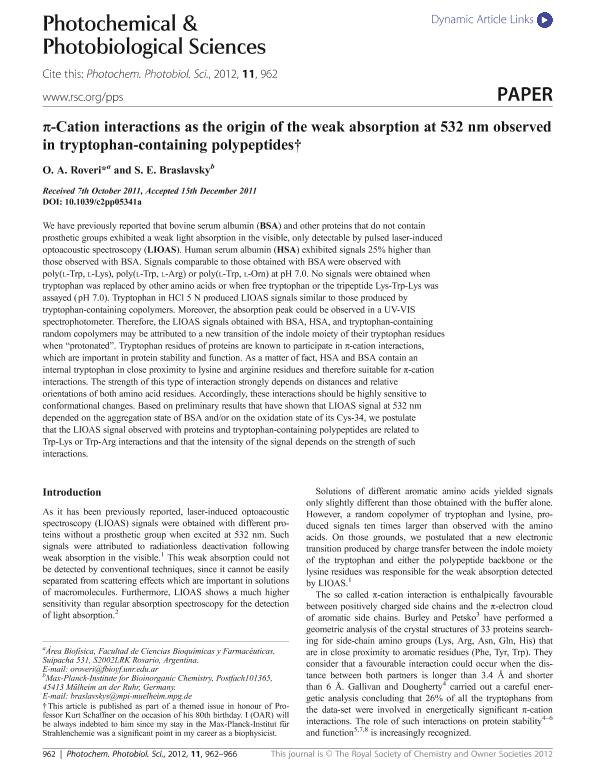Mostrar el registro sencillo del ítem
dc.contributor.author
Roveri, Oscar Angel

dc.contributor.author
Braslavsky, S. E.
dc.date.available
2023-04-27T13:01:04Z
dc.date.issued
2012-06
dc.identifier.citation
Roveri, Oscar Angel; Braslavsky, S. E.; π-Cation interactions as the origin of the weak absorption at 532 nm observed in tryptophan-containing polypeptides; Royal Society of Chemistry; Photochemical and Photobiological Sciences; 11; 6-2012; 962-966
dc.identifier.issn
1474-905X
dc.identifier.uri
http://hdl.handle.net/11336/195617
dc.description.abstract
We have previously reported that bovine serum albumin (BSA) and other proteins that do not contain prosthetic groups exhibited a weak light absorption in the visible, only detectable by pulsed laser-induced optoacoustic spectroscopy (LIOAS). Human serum albumin (HSA) exhibited signals 25% higher than those observed with BSA. Signals comparable to those obtained with BSA were observed with poly(L-Trp, L-Lys), poly(L-Trp, L-Arg) or poly(L-Trp, L-Orn) at pH 7.0. No signals were obtained when tryptophan was replaced by other amino acids or when free tryptophan or the tripeptide Lys-Trp-Lys was assayed ( pH 7.0). Tryptophan in HCl 5 N produced LIOAS signals similar to those produced by tryptophan-containing copolymers. Moreover, the absorption peak could be observed in a UV-VIS spectrophotometer. Therefore, the LIOAS signals obtained with BSA, HSA, and tryptophan-containing random copolymers may be attributed to a new transition of the indole moiety of their tryptophan residues when “protonated”. Tryptophan residues of proteins are known to participate in π-cation interactions, which are important in protein stability and function. As a matter of fact, HSA and BSA contain an internal tryptophan in close proximity to lysine and arginine residues and therefore suitable for π-cation interactions. The strength of this type of interaction strongly depends on distances and relative orientations of both amino acid residues. Accordingly, these interactions should be highly sensitive to conformational changes. Based on preliminary results that have shown that LIOAS signal at 532 nm depended on the aggregation state of BSA and/or on the oxidation state of its Cys-34, we postulate that the LIOAS signal observed with proteins and tryptophan-containing polypeptides are related to Trp-Lys or Trp-Arg interactions and that the intensity of the signal depends on the strength of such interactions.
dc.format
application/pdf
dc.language.iso
eng
dc.publisher
Royal Society of Chemistry

dc.rights
info:eu-repo/semantics/openAccess
dc.rights.uri
https://creativecommons.org/licenses/by-nc-sa/2.5/ar/
dc.subject
PI-CATION INTERACTION
dc.subject
HUMAN ALBUMIN
dc.subject
TRYPTOPHAN
dc.subject
LIOAS
dc.subject.classification
Biofísica

dc.subject.classification
Ciencias Biológicas

dc.subject.classification
CIENCIAS NATURALES Y EXACTAS

dc.title
π-Cation interactions as the origin of the weak absorption at 532 nm observed in tryptophan-containing polypeptides
dc.type
info:eu-repo/semantics/article
dc.type
info:ar-repo/semantics/artículo
dc.type
info:eu-repo/semantics/publishedVersion
dc.date.updated
2023-04-19T17:27:23Z
dc.journal.volume
11
dc.journal.pagination
962-966
dc.journal.pais
Reino Unido

dc.journal.ciudad
Cambridge
dc.description.fil
Fil: Roveri, Oscar Angel. Universidad Nacional de Rosario. Facultad de Ciencias Bioquímicas y Farmacéuticas; Argentina. Consejo Nacional de Investigaciones Científicas y Técnicas. Centro Científico Tecnológico Conicet - Rosario; Argentina
dc.description.fil
Fil: Braslavsky, S. E.. Max-Planck-Institute for Bioinorganic Chemistry; Alemania
dc.journal.title
Photochemical and Photobiological Sciences

dc.relation.alternativeid
info:eu-repo/semantics/altIdentifier/doi/http://dx.doi.org/10.1038/c2pp05341a
dc.relation.alternativeid
info:eu-repo/semantics/altIdentifier/url/https://link.springer.com/article/10.1039/c2pp05341a
Archivos asociados
